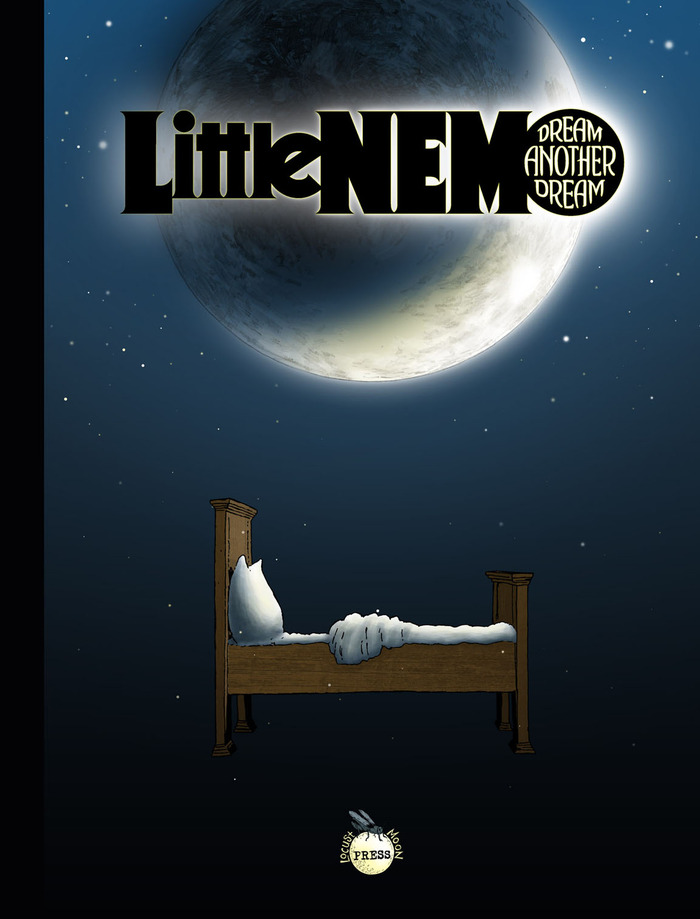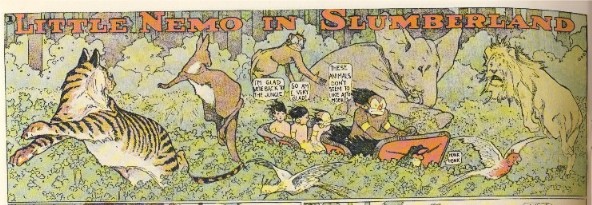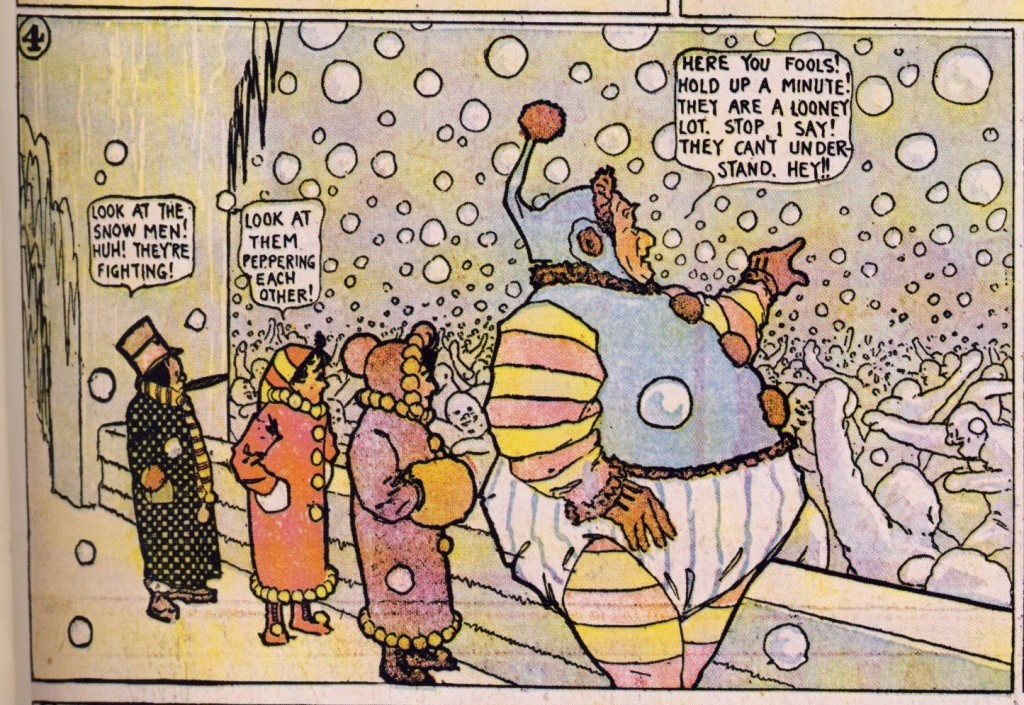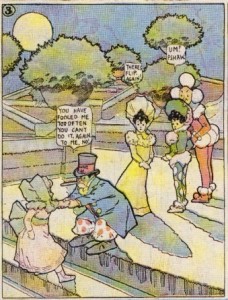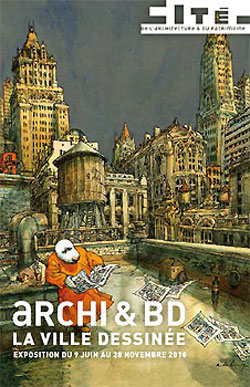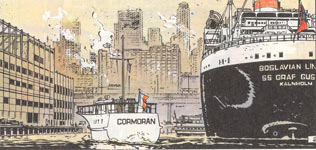This review originally appeared in The Comics Journal
Winsor McCay occupies roughly the same place in comics as Shakespeare does in English literature. A crowd-pleasing, intensely accessible entertainer, he is also an artists’ artist, admired by creators in every corner of the medium, from Art Spiegelman to Johnny Ryan, Neil Gaiman to Charles Schulz, Frank King to Alan Moore, Carl Barks to Chris Ware. If any comic artist’s place in the canon is assured, it’s Winsor McCay’s.
It’s that *if* which is the stumbling block, though. Despite huge gains in recent years, comics remain an aesthetically dubious medium — there really is, and probably at the moment can be, no comic that is as solidly and universally validated as Shakespeare, or Hemingway, or any number of other classic works of literature. Everybody who cares may know that McCay is brilliant, but even people who don’t care know that Shakespeare is a genius. Indeed, Shakespeare’s reputation is so overwhelming that it’s possible to read his plays without even noticing their thorough-going vulgarity and silliness. McCay is not so fortunate — or, perhaps, unfortunate. Be that as it may, a casual viewer of a McCay strip is as likely to be struck by the vaudeville schtick, the crude visual humor, or the gratuitous sight gags as he is by the formal and visual invention.
Ulrich Merkl’s collection of McCay’s “Dream of the Rarebit Fiend’ is poised to right this situation through sheer massive presence. Weighing in at 470 enormously oversized pages and $114, this is one of those cultural objects designed to double as a bludgeon. Merkl did almost all the work himself — image research, image restoration, copyright solicitations, scanning, advertising, and a host of etceteras —and the finished product is awe-inspiring. Not only has Merkl provided a impressive selection of the more than 800 Rarebit Fiend strips, but he also reproduces a huge number of other contemporary strips which McCay drew, influenced, or was influenced by. There are also essays by various scholars, a careful chronology of McCay’s life, and several articles which McCay wrote himself for various newspapers back in the day. And, on the included DVD, you can see all the extant episodes of the Rarebit Fiend as well as a copy of one of McCay’s most famous animated features, “Gertie on Tour.”
Naturally, my first reaction when I received this in the mail was, “Holy shit!” And it is, in fact, one of the most impressive coffee table books I’ve staggered around underneath. One hundred and fourteen dollars is a lot of money, but if you can afford to shell it out for this tome, I don’t think you’ll be disappointed. McCay deserves every superlative he’s ever received, and this collection is meticulously researched and presented. I do, though, have one suggestion which will vastly increase your reading pleasure: skim the biographical bits if you must, but for God’s sake, skip the critical prose.
This shouldn’t be too much of a burden. After all, who on earth actually reads art books? Nobody but overly conscientious reviewers, surely. And there’s a good reason for that. As I waded through reams of tiny type, the shock and awe began to turn into irritation and boredom. And, inevitably, unpleasant questions began to arise. Yes, an enormous amount of effort went into producing this volume, but to what purpose? For example, Merkl takes pains throughout to point to other artistic works inspired by the Rarebit Fiend. Some of these seem reasonable and convincing — for instance, it’s clear that Frank King’s contemporary “Bobby Make Believe” series was heavily indebted to McCay. The 1935 short live-action film “The Fresh Lobster ,“ also seems likely to have been a direct homage. And it certainly seems possible that the animated Dumbo was inspired by McCay’s visual example in general, and perhaps even (as in the flying-bed sequence Merkl references) in specific details. But there are a whole series of other references which seem, to put it kindly, dubious. We’re really supposed to believe that James Cameron saw episode 243 of the Rarebit Fiend (in which a man bashes a pliable tin soldier) and was thereby inspired to create the pliable metal robot in Terminator II? Or that R. Crumb couldn’t have come up with the idea of an anthropomorphic boiler unless he’d seen Rarebit Fiend episode 49? Or that McCay invented flying saucers even though they were current at least twenty years before he started drawing his strips?
Admittedly, the UFO reference seems like something of a joke — McCay’s supposed “flying saucer” is a drawing of a giant hat. Still, the assertion can be proven wrong with five minutes on Google, which does tend to vitiate the punchline. Besides, McCay is one of the most talented and influential figures in both cartooning and animation. Must he have predicted the future in order for him to be relevant? Does his importance really depend on whether or not he directly influenced recognizable modern figures like Cameron and Crumb?
For Merkl the answer, unfortunately, seems to be yes. Like some latter-day rarebit fiend, Merkl bends, stretches, and twists himself spasmodically, trying desperately to provide a rationale and defense of McCay’s artwork. Annoyingly, all the flailing tends to obscure the actual achievements. For instance, in one article Merkl claims that the Dream of the Rarebit Fiend is weirder and more adult than McCay’s better known Little Nemo. It’s an arguable point — though, to be devil’s advocate, McCay used many of the exact same ideas in both, and the longer narratives in Little Nemo allowed for more intricately absurd storylines. In any case, to make his point, Merkl first rather feebly protests that he doesn’t want “to diminish the quality of Little Nemo,” and then goes on say this:
“A further reason for the greater popularity of *Little Nemo* is its emphasis on optical effect rather than actual content. It is well known that the human brain is much faster in taking in optical impressions than it is in absorbing texts and plots. We are all aware of this phenomenon in our modern society: a film based on a book is nearly always more popular than the book itself and a hit single does not sell at all without a cool video clip accompanying it.”
In other words, Nemo is popular because it’s eye candy for the groundlings, like music videos. More sophisticated viewers, supposedly, will gravitate to the Rarebit Fiend. The problem is that, in denigrating “optical effect,” Merkl ends up undercutting, not just Little Nemo, but McCay’s work in general. Nobody but nobody is going to get through 300 pages of Rarebit Fiend on the plot— it’s McCay’s formal mastery which makes his strips special. Indeed, the belief that visual data and beauty is childish and low-brow is exactly why Merkl feels the need to defend the strips in the first place. In trying to bolster McCay’s cultural position in general, and this work in particular, Merkl helplessly reproduces the sneers of those he’s supposedly repudiating.
The most elaborate effort to salvage McCay for the high-brow, though, is written, not by Merkl, but by Dr. Jeremy Taylor, a “Unitarian Universalist minister” who “blends the values of spirituality with an active social conscience and a Jungian perspective.” This is not, to put it mildly, a propitious set of credentials. Alas, Dr. Taylor’s article fulfills every one of the promises made in the author bio. Atrociously titled “Some Archetypal Symbolic Aspects of “Dream of the Rarebit Fiend,” this interminable screed is devoted to the proposition that McCay is, in fact, Joseph Campbell.
Taylor begins by wondering aloud why it is that no one has ever tried to find the “symbolic meanings” of McCay’s “various artistic dream creations as dreams.” As it happens, I can explain this conundrum: no one has done it because it’s a fucking stupid idea. McCay isn’t Kafka , or even Dali — he’s not especially interested in dreams as a psychological or spiritual phenomena. In the Rarebit Fiend series, especially, dreams are explained entirely and repeatedly by linking them to the digestive system. In fact, many of the strips use dreams simply as a gimmick to set up slapstick or vaudeville type humor. In episode 150, for instance, a man digs through the center of the earth and comes out the other side, where he is set upon by pidgin-spouting Chinese caricatures who beat him with sticks. (But isn’t that a metaphor for all of our dark journeys?)
That isn’t to say that none of these strips have Freudian overtones: episode 137 (printed opposite 150, as it happens) is about a woman who Oedipally transfers her affections from her husband to a ravenous warthog. McCay’s interest in violating the human body in various ways — enlarging variously, noses, heads, legs, arms, ears and every other non-scandalous body part — is also suggestive. And could the ever-mentioned Rarebit be seen as the residue of the Lacanian Real? In any case (and with tongue in or out of cheek) one could certainly use various dream theories to talk about the Rarebit Fiend if one wanted, just as these theories have been used to talk about any number of narrative forms, from literature to film.
But to talk about the comics actually *as if* they are dreams rather than artistic productions ends up — under the guise of making McCay more universal and profound — actually flattening his artistry. For example, Taylor claims that Freud, Jung, Adler, and every other dream theorist who ever swung a beard are all simultaneously correct. He then goes on, with similar ingenuous ecumenicalism, to state that “every dream simultaneously exhibits and reveals all these seemingly different levels of meaning….” Okay — but then what’s so special about Winsor McCay? If everybody’s dreams are equally meaningful, why should we bother with someone else’s? Couldn’t we just make our own? Taylor thrashes around trying to answer this question, even comparing McCay rather desperately to Einstein. His argument, though, eventually comes to rest on the conclusion of each Rarebit Fiend episode. That moment of returning consciousness, Taylor suggests, is a symbol of mankind’s entry into the afterlife. “McCay’s awakening dreamers touch a very deep chord in us when we encounter them, always in the last frame, always one step closer to our own awakening.” A heaven populated by chronic dyspeptics whining about their last dinner is certainly an entertaining idea — whether it actually tells us anything about McCay’s motivations, his interests, or his art is another question entirely.
Taylor’s crankery is, at least, enthusiastically extroverted; it gives the book a breathless amateur appeal (rather like that bestowed on TCJ itself by Kenneth Smith’s natterings.) The most offensive result of the tome’s effort to defend McCay, though, involves an uncharacteristic and wholly unadmirable restraint. Merkl is expansively garrulous on virutally all things Winsor McCay. Every time a reference to circus animals appears in one of the Rarebit Fiend strips, Merkl glosses it with an extensive discussion of McCay’s work in vaudeville and traveling shows. Whenever there is a reference to a mother-in-law, Merkl includes a paragraph or two about McCay’s stormy relationship with his own. When hotels are mentioned, Merkl lovingly includes a paragraph about how much time McCay spent on the road. When a character speaks with a German accent, Merkl explains how and where McCay was likely to have interacted with German immigrants.
On one point, however, Merkl is silent. That is on the subject of race. As anyone familiar with his work knows, Winsor McCay often used vicious racist caricatures in his work. If you page through this volume, you will see many of them. McCay’s first strip was called “A Tale of the Jungle Imps” and featured, in McCay’s words “aggressive Imps, seminaked black children,” decked out in giant blackface lips and cannibal loincloths. One of these barely sentient “imps” became a central character (named “Impy”) in *Little Nemo*. The *Rarebit Fiend*, too, traffics in racist caricature. These are mostly in walk-on parts, but occasionally (as in episode 374) they are used as central figures. In either case, black people are depicted using the most offensive kind of iconography and dialect — when they aren’t speaking a nonsense jungle pidgin, they all spout phrases like “Good lawdy!” and “What ails dis heah bed?”
McCay’s racism is, of course, partly due to his era — northern whites were arguably more racist in the early decades of the twentieth century than ever before or since. It’s also attributable to his roots in vaudeville, where blackface and racial humor were a standard part of the repertoire (in fact, episode 680 seems to be meant to feature a performer in blackface, rather than an actual African-American.) Merkl could have provided this context — and he also could have noted that, as one of the pioneers of comic-strips and animation, McCay’s racism had a long-term negative effect on the representations of blacks in both mediums. Surely this information — involving, as it does, important political and genre concerns, as well as one of McCay’s most consistent motifs — is at least as important as the fact that McCay liked to draw long-necked critters. But Merkl tells us the second repeatedly and never mentions the first…except to note defensively on the back cover that the book will appeal to those who enjoy “the bizarre, the absurd, and the politically incorrect.” So, it seems, we’re so desperate to find something worthwhile in McCay’s art that we have to turn his racism into a selling point — albeit one that even Merkl is a little reluctant to highlight directly.
*************
None of the above is intended to undermine McCay’s reputation. Indeed, I don’t really see how his reputation *can* be undermined. Merkl’s anxiety couldn’t be more baseless. McCay didn’t influence James Cameron; he doesn’t deal in mythopoetic truths; he’s a racist. As far as his status as an artist goes, it couldn’t matter less.
What does matter are strips like episode 306. Perhaps the single most unsettling comic in the book, the opening panel shows a dreamer, eyes closed, exclaiming “Oh! I can’t move!” As the sleeper continues to bemoan his fate, a couple of pretty birds land on his face. Then a centipede crawls up his cheek; the birds build a nest in his mouth, flies start to crawl across his forehead; a pig chews on his neck. And all the time the sleeper moans and shouts — “Oh! Oh! I know I’ll die!…I seem to be smothering too! Oh! Oh! I’m dying!” The panels are arranged in four columns of four, and each image is exactly the same as the last except for the addition of more animals — like much of McCay’s Rarebit work, it’s essentially a series of animated cells laid out on the page. As the panels fill with more and more animals, the simple lines of the pillow and the bed clothes start to read, almost magically, as an outdoor landscape rather than an interior space. The sleeper is literally swallowed by the natural world, and the temporary paralysis of sleep turns into a frightening vision of death — a vision only made starker by the fact that the marauding animals are both oblivious to the sleeper’s fate and incongruously cute. The final panel, in which the speaker awakes to shout “I’ll never forget this dream if I live a million years!” is a well-deserved victory lap — McCay knew that he’d outdone himself.
Though episode 306 is an exceptional achievement, it is also typical of the way in which the Rarebit Fiend series is organized. In Little Nemo, McCay’s formal mastery is employed —not always, but generally — in the service of, or for the delight of, his characters. Little Nemo is the recurring, amazed explorer of McCay’s marvelous worlds. As in many children’s books, the overall point is to create a sense of wonder — McCay is a magician, his technical mastery the pyrotechnic effects which draw “oohs” from both Nemo and the reader.
The relation between form and content in the “Rarebit Fiend” is somewhat different. McCay is still, of course, interested in formal experimentation. But now his talents are used, not to amaze his characters, but to torment them. This applies to 306 —in which the time lapse tour de force is used to paralyze the unfortunate dreamer But it also works for any number of other strips: episode 232, where McCay’s playful use of scale turns some poor schmuck into a football; episode 416, where the panel backgrounds come unstuck and smother the unfortunate protagonist; episode 284, where another dreamer is tormented by the changing orientation of the background; and so forth.
Part of the difference in emphasis is caused by the fact that, unlike Little Nemo, the Rarebit Fiend has no recurring characters. We know almost nothing about each dreamer except for his or her dream — the people in the strip are mere raw material, which McCay grinds up in his mercilessly jovial contraptions. To emphasize their interchangeability further, the dreamers all speak with a kind of aphasiac repetition. The mummified woman in episode 358 who keeps declaring, “Cupid’s darts have made my heart look like a throbbing sponge!” is bizarrely typical. In the *Rarebit Fiend*, dialogue isn’t used to advance plot or show character, but simply to reiterate a complaint over and over, a whine that, in its anonymous persistence, becomes divorced from any actual human utterance and turns into a kind of semi-automated querelousness.
McCay’s absurdist situations and his repetitive language both suggest Beckett, and the two do have a lot in common — not least their love of slapstick. But though Beckett’s characters are atomized and hopeless, their struggles are, for that very reason, ennobling: “I can’t go on…I’ll go on.” In contrast, there isn’t anything ennobling about the trials McCay puts his characters through. Indeed, in the Rarebit Fiend, “man” signifies, not spirit or soul, but simply an iconic agglomeration of limbs and protuberances which exist to be variously mashed and spindled.
Perhaps the best illustration of the difference is in episode 340, which might be titled, “Waiting for Winsor McCay.” A Spanish count calls on a woman, who rejects his love because she is enamored of “Silas” —McCay’s pen name. Driven to madness by the woman’s preference for the “plain rarebit dream artist”, the count tears apart the panel, reducing both the woman and himself to shredded wads of paper. As the last bit of him drops to earth, the count mutters “’Tis sad to die thusly.”
Obviously, this is not Beckett’s spiritual wasteland. But it is, for all that, a wasteland. The Spanish count and the object of his affection are both directly out of melodrama. They’re hollow pasteboard, even before the strip starts to deconstruct itself. The last panel but one is almost all white, with a few scattered bits of paper at the bottom, on one of which we can see a bit of the woman’s horrified face. The last panel is, of course, a picture of the dreamer waking up — but who is dreaming this, anyway? The fake woman? The even less realistic count? No…it’s an elderly lady who wakes up exclaiming “Oh! Me! I had such an awful dream about our oldest daughter just now….” The surprise entrance of a new character to have the dream only emphasizes the arbitrariness of the trope. Anyone can dream anything in McCay, not because we’re all profoundly alike, but because no one is actually there. It’s just lines on paper, the only meaning the craft of the artist, chuckling as he devises another formal nightmare.
Or, to put it another way, Beckett is a humanist — McCay isn’t. But what is he? As I was putting this essay together, I thought at first I might try to compare him to the Italian futurists, who were, like McCay, a lot more interested in mechanism and violence than in morality and love. Then again, I considered drawing a connection to thrash or death metal — a tight formal structure the content of which is its own form celebrated as brutality. But the thing is, both the futurists and metal are linked to actual philosophical and political programs— their nihilism is a conscious, militant choice. McCay is more about the nothing that is not there: his strips really aren’t passionate about anything except their own glorious surfaces. As such, the only comparisons that really work are the most obvious; classic Warner Bros. cartoons, Ernie Bushmiller’s “Nancy”… creations where the laff and the delivery system are ends unto themselves.
No surprise then, that Merkl is rather desperate to find some other meaning — anyother meaning — in the strip. To the extent that comics have managed to gain acceptance in the west, it’s been through the stolidly middle-brow artistic project of spouting universal human truths and universal human pathos. George Herriman or Charles Schulz can be fit into that program with a little shoving, but McCay? His incredible power of invention, his formal mastery, and his preeminent place in history mark him ineradicably as one of the medium’s greatest creators. Yet his comics are so thoroughly and even aggressively shallow that its impossible to talk seriously about them without making oneself look like a fool. He remains, then, comicdoms indigestible bolus; a dish which can’t be refused, but which, when swallowed, brings forth anxious and humiliating visions. Who’s the butt of McCay’s dreams? If you answered “We all are,” then I sentence you to reading every bit of prose in Merkl’s volume. The rest of you are welcome to just look at the goofy pictures.

